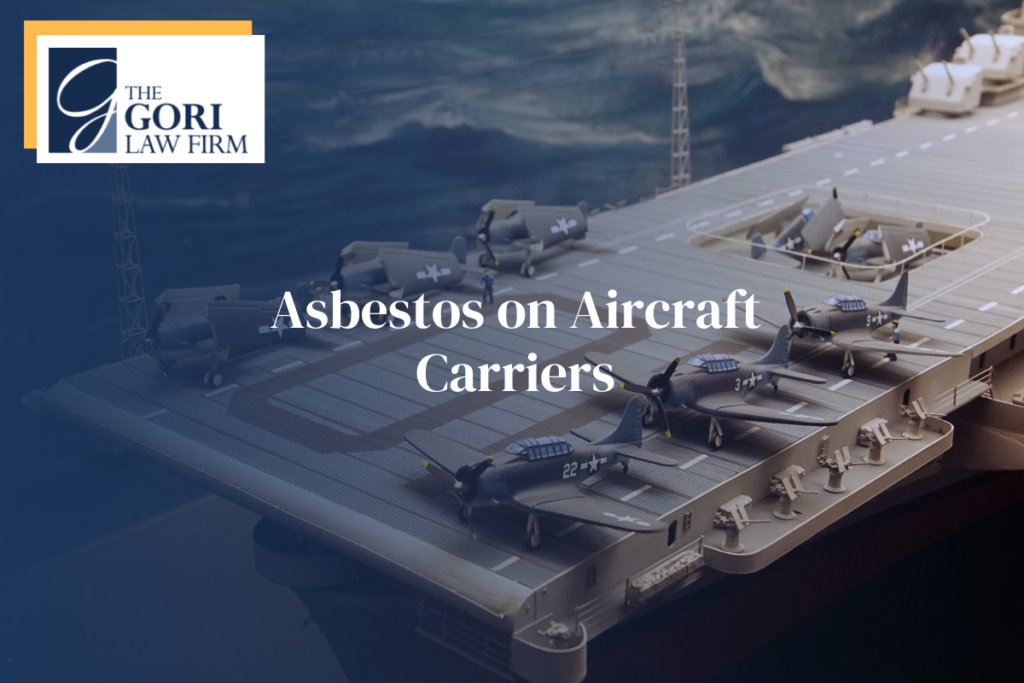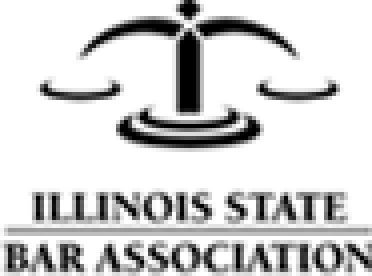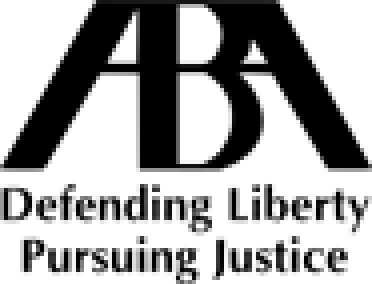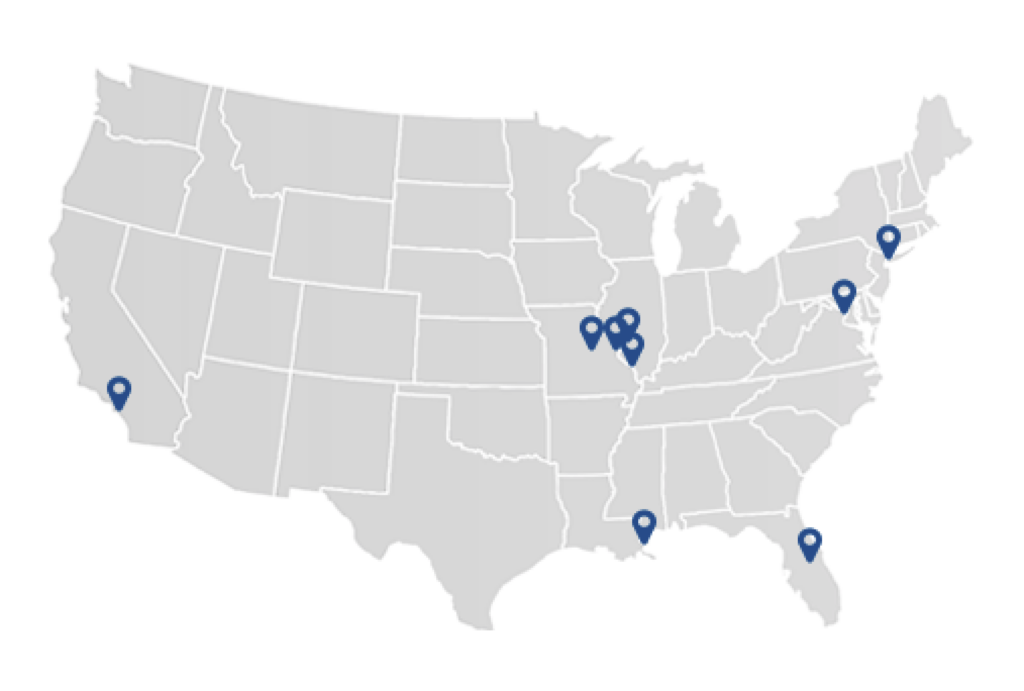Asbestos on Aircraft Carriers
Aircraft carriers have exposed many servicemen to asbestos, causing serious health issues like mesothelioma and lung cancer. Notable ships like the USS America and USS Antietam played key roles in conflicts but contained hazardous materials. Veterans should consult doctors about asbestos-related diseases and seek legal advice for compensation and treatment.

Home » Nationwide Mesothelioma Lawyers » Veterans and Mesothelioma » Navy » Asbestos on Aircraft Carriers
- Content last modified:
Navigate this page
- USS America (CV-66) (ex-CVA 66)
- USS Antietam (CVS 36) (ex-CVA 36)
- USS Bennington (CVS 20) (ex-CV 20, CVA 20)
- USS Bon Homme Richard (CVA 31) (ex-CV 31)
- USS Constellation (CV 64) (ex-CVA 64)
- USS Coral Sea (CV 43) (ex-CV 43, CVB 43, CVA 43)
- USS Enterprise (CVN 65) (ex-CVAN 65)
- USS Essex (CVS 9) (ex-CVA 9)
- USS Forrestal (AVT 59) (ex-CVB 59, CVA 59, CV 59)
- USS Franklin D Roosevelt (CV42)
- USS Hancock (CV 19)
- USS Hornet (CVS 12) (ex-KEARSARGE CV 12, CVA 12)
- USS Independence (CV 62) (ex-CVA 62)
- USS Intrepid (CVS 11) (ex-CV 11, CVA 11)
- USS John F Kennedy (CV 67) (ex-CVA 67)
- USS Kearsarge (CVS 33) (ex-CV 33, CVA 33)
- USS Kitty Hawk (CV 63) (ex-CVA 63)
- USS Lake Champlain (CVS 39) (ex- CV 39, CVA 39)
- USS Lexington (AVT 16) (ex-CABOT, CV 16, CVA 16, CVS 16, CVT 16)
- USS Marcus Island (CVE 77)
- USS Midway (CV 41) (ex-CVB 41, CVA 41)
- USS Oriskany (CV 34)
- USS Petfrof Bay (CVE 80)
- USS Randolph (CVS 15) (ex-CV 15, CVA 15)
- USS Ranger (CV 61) (ex- CVA 61)
- USS Saratoga (CV 60) (ex-CVA 60)
- USS Savo Island (CVE 78)
- USS Shangri-La (CVS 38) (ex-CV 38, CVA 38)
- USS Suwannee (CVE 27)
- USS Ticonderoga (CV 14)
- USS Wright (CVL 49)
- USS Yorktown (CVS 10) (ex-CV 10, CVA 10)
- We Can Help
Aircraft Carriers are war ships that are structured to deploy and recover aircraft. They are essentially traveling air bases that have been serving the Navy for one hundred years. These ships are very important to the Navy, and played a major role in World War II. Typically they are considered the capital ship of the fleet and are very expensive to build and maintain; there are only twenty one currently operating throughout the world. Often called “floating cities” aircraft carriers lack the firepower of other types of ships and are usually accompanied by several other ships in the fleet for protection. Unfortunately, while serving their country, these sailors were exposed to asbestos while on board aircraft carriers. Asbestos was found in a number of areas on these ships, in particular the insulation that lined piping aboard these vessels.
Anyone who served on an aircraft carrier should speak with their doctor regarding asbestos related diseases, such as Mesothelioma and Lung Cancer, and the treatment options available.
USS America (CV-66) (ex-CVA 66)
One of the most important carriers in the history of the navy, the USS America exposed many service men and women to asbestos dust.
- Classification: Multi-Purpose Aircraft Carrier
- Status: Disposed of in Support of Fleet Training Exercise
- Fleet:
- Launch Date: 2/1/1964
- Commission Date: 1/23/1965
- Decommission Date: 8/9/1996
USS America spent most of her time in the Mediterranean; however she was briefly in Southeast Asia, the Caribbean and Indian Ocean before she was decommissioned in 1996. The USS America received 8 battle starts for her contributions to the efforts in Vietnam and the Persian Gulf. This vessel was used by the Navy for over 30 years and achieved unparalleled service as it is considered one of the most important carriers in the history of the U.S. Navy.
USS Antietam (CVS 36) (ex-CVA 36)
The USS Antietam, launched during WWII, was built with many products and materials containing asbestos. Now, many servicemen and shipbuilders are suffering from mesothelioma and lung cancer.
- Classification: ASW (Anti-Submarine Warfare) Support Aircraft Carrier
- Status: Disposed of by Navy Sale
- Fleet: Pacific/Atlantic/6th
- Launch Date: 8/20/1944
- Commission Date: 1/28/1945
- Decommission Date: 5/8/1963
During World War II, USS Antietam spent a little more than three years in the Far East, specifically the Yellow Sea, however she did travel to Japan, the Philippines, and the Marianas during that time. During the Korean war, she served in one combat deployment, making four cruises with Task Force 77 off the coast of Korea. In between fighting assignments while she was in Yokosuka Japan, her air group carried out a number of missions in support of United Nations forces combating North Korean aggression, earning her two battle stars for service in the Korean conflict. The USS Antietam went on to become America’s first angled-deck aircraft carrier. On two occasions she provided humanitarian services to victims of hurricane damage by transporting medical supplies, the first in September of 1962 in Texas after Hurricane Carla and the second in October of 1961 in Honduras after Hurricane Hattie.
USS Bennington (CVS 20) (ex-CV 20, CVA 20)
A support aircraft carrier, the USS Bennington contained a significant amount of asbestos and exposed many servicemen, who now suffer from mesothelioma and lung cancer.
- Classification: ASW (Anti-Submarine Warfare) Support Aircraft Carrier
- Status: Disposed of by Navy Sale
- Fleet: Pacific
- Launch Date: 2/26/1944
- Commission Date: 8/6/1944
- Decommission Date: 1/15/1970
Affectionately called “Big Benn” by her crew, the USS Bennington arrived in Pearl Harbor in January of 1945 and participated in strikes against the Japanese home islands, Volcano Islands, and Okinawa. Her planes even participated in the mass flight over the USS Missouri (BB-63) and Tokyo during the surrender ceremonies. Tragically, on May 28, 1954, fluid in one of her catapults exploded which set off a series of secondary explosions and ultimately killing 103 crewman and injured 201 others. These men were recognized and honored for their bravery and heroism in April of 1955.
USS Bon Homme Richard (CVA 31) (ex-CV 31)
Having seen action during WWII and the Korean war, the USS Bon Homme Richard was decommissioned in 1971. Navy veterans and shipbuilders who worked on her may now be suffering from mesothelioma and lung cancer.
- Classification: Attack Aircraft Carrier
- Status: Disposed of by scrapping, dismantling
- Fleet: Naval/Pacific
- Launch Date: 4/29/1944
- Commission Date: 11/26/1944
- Decommission Date: 7/2/1971
USS Bon Homme Richard was deployed in March of 1945 and joined other carriers in the final raids on Japan. She also joined the fighting in the Korean War before receiving upgrades consisting of an angled flight deck, enclosed bow, enlarged elevators, and steam catapults. No stranger to war, she also served in the Vietnam War. USS Bon Homme Richard received one battle star for her World War II service and five battle stars for her participation in the Korean conflict.
USS Constellation (CV 64) (ex-CVA 64)
The multi-purpose aircraft carrier USS Constellation was originally made using asbestos.
- Classification: Multi-Purpose Aircraft Carrier
- Status: Stricken, to be disposed of
- Fleet:
- Launch Date: 10/8/1960
- Commission Date: 10/27/1961
- Decommission Date: 8/6/2003
USS Constellation, known affectionately as “Connie,” spent the majority of her time in the Western Pacific. Before she could begin her tour of duty however, a tragic fire broke out during construction killing nearly 50 men and injuring several others. The damage cost almost $75 million, and delayed commissioning for seven months. Finally, after she was commissioned, she was among the more involved carriers in the early days of the Vietnam War. Through the 1970’s and 1980s she served throughout the world participating in support operations in Yemen and the Middle East. In her final deployment, she participated in the global war on terror in 2002.
USS Coral Sea (CV 43) (ex-CV 43, CVB 43, CVA 43)
The aircraft carrier USS Coral was built shortly after WWII using materials contaminated with asbestos. Navy veterans who now suffer from mesothelioma and lung cancer caused by asbestos exposure have legal rights.
- Classification: Multi-Purpose Aircraft Carrier
- Status: Disposed of by scrapping, dismantling
- Fleet: Atlantic/6th/7th
- Launch Date: 4/2/1946
- Commission Date: 10/1/1947
- Decommission Date: 4/30/1990
USS Coral Sea sailed for her first tour of duty in the Mediterranean and spent the majority of her time there, only briefly interrupted to sail to the Caribbean, South, and Central America. She was appointed the flagship for Carrier Division 6 and as such, she provided an insurmountable amount of honorable service in collaboration with NATO during the Beehive I exercise, which brought the Deputy Secretary of Defense on board. The USS Coral Sea was bestowed with the honor of taking the Judiciary Committee of the United States House of Representatives on a multi-day cruise . She also had the pleasure of welcoming the King and Queen of Greece on board as visitors in October of 1956. During the Suez Crisis, she aided in the evacuation of American citizens from the troubled area. The USS Coral Sea received an overhaul which made her the first ship to develop a configuration for a procedure that made it possible for two onboard attack groups to share a maintenance program simultaneously. Years later, in the late 1980’s, she responded to an S.O.S. call from the USS Iowa who had just suffered a horrific explosion in one of their gun turrets that ultimately killed 47 sailors. She provided emergency care while a specialized team removed dangerous powder charges from Iowa’s guns in order to prevent another explosion.
USS Enterprise (CVN 65) (ex-CVAN 65)
The oldest vessel still active in the U.S. Navy, the USS Enterprise was built in 1960 as the first nuclear-powered aircraft carrier. She was also built with asbestos, exposing many who served on her to the dangerous carcinogen.
- Classification: Multi-Purpose Aircraft Carrier
- Status: Active, In Commission
- Fleet: Atlantic
- Launch Date: 9/24/1960
- Commission Date: 11/25/1961
- Decommission Date: NA
The USS Enterprise has the distinction of being both the first nuclear-powered aircraft carrier and the longest carrier in the world. It is also the oldest vessel still active in the US Fleet. She is due to be decommissioned in 2013. Thus far in her career, she has participated in the following: tracking for the Friendship 7 space shuttle capsule that orbited the earth, formed part of the blockade during the Cuban Missile Crisis, Operation Sea Orbit to sail around the world, participated in the Vietnam War, aided in disaster relief for Typhoon Gervaise, various operations in the Middle East, several training exercises with the British Royal Navy, among many others.
USS Essex (CVS 9) (ex-CVA 9)
- Classification: ASW (Anti-Submarine Warfare) Support Aircraft Carrier
- Status: Disposed of by Navy Sale
- Fleet: Pacific/7th/Atlantic/6th/2nd
- Launch Date: 7/31/1942
- Commission Date: 12/31/1942
- Decommission Date: 6/30/1969
The USS Essex was a highly decorated aircraft carrier used in World War II and Korea and a key player in several victorious battles, including sinking eight Japanese ships which constitutes the most formidable carrier striking force to date. On November 25, 1944, she received a kamikaze hit on her port side flight deck which resulted in 15 deaths and 44 injuries. She also withstood several typhoons during the war, however she never wavered and finished out the war with pride. She participated in the Cuban Missile Crisis Blockade and also helped with the Apollo 7 recovery. The USS Essex received the Presidential Unit Citation and 13 battle stars for her World War II service and four battle stars and the Navy Unit Commendation for her Korean War service.
USS Forrestal (AVT 59) (ex-CVB 59, CVA 59, CV 59)
The multi-purpose aircraft carrier USS Forrestal was built using asbestos. Veterans and shipbuilders were often exposed to the carcinogenic mineral and now suffer from cancer and other asbestos-related diseases.
- Classification: Multi-Purpose Aircraft Carrier
- Status: Stricken, to be disposed of
- Fleet: 6th
- Launch Date: 12/11/1954
- Commission Date: 9/29/1955
- Decommission Date: 9/11/1993
The USS Forrestal spent most of her time in the Atlantic, Caribbean, and Mediterranean. She participated in training exercises frequently. The USS Forrestal is also known for her hospitality, when she docked at a port she was open to the public and offered tours to dignitaries. The King of Jordan and the Secretary of Defense were two visitors that she welcomed aboard.
USS Franklin D Roosevelt (CV42)
The Franklin D Roosevelt was built at the end of WWII. Many of the components of the ship contained asbestos, a deadly carcinogen.
- Classification: Multi-Purpose Aircraft Carrier
- Status: Disposed of by Navy sale
- Fleet: 8th/6th
- Launch Date: 4/29/1945
- Commission Date: 10/27/1945
- Decommission Date: 9/30/1977
The USS Franklin D Roosevelt spent most of her time in the Mediterranean and Caribbean, interrupted by one cruise to the Western Pacific in 1966.
USS Hancock (CV 19)
The Aircraft Carrier USS Hancock was built in WWII. Like other ships of that type and class, it was built with materials that contained asbestos.
- Classification: Multi-Purpose Aircraft Carrier
- Status: Disposed of by Navy sale
- Fleet: 5th/7th
- Launch Date: 1/24/1944
- Commission Date: 4/15/1944
- Decommission Date: 1/30/1976
USS Hancock helped with raids on the South China Sea, Okinawa, and the Philippines. At Okinawa, her planes destroyed 7 enemy aircraft, 12 torpedo boats, 2 midget submarines, 4 cargo ships, and a number of sampans. She participated in several successful raids throughout the war, one in particular against Tokyo, in which her planes downed 83 enemy planes in two days. The USS Hancock was damaged by a typhoon and suicide plane that killed 62 crewmen and injured 71 others. Her planes flew overhead on the day the Japanese Surrender was signed on the USS Missouri. After the war, she was modernized and became the first carrier in the US Fleet to have steam catapults capable of launching high performance jets. She was also involved in raids during the Vietnam War. The USS Hancock received a Navy Unit Commendation for her outstanding combat record along with four battle stars for her service in World War II.
USS Hornet (CVS 12) (ex-KEARSARGE CV 12, CVA 12)
The Support Aircraft Carrier USS Hornet spent most of her time int he Pacific. Decommissioned in 1970, many veterans who served on her were exposed to asbestos dust.
- Classification: ASW (Anti-Submarine Warfare) Support Aircraft Carrier
- Status: Donated as a Museum and Memorial
- (Currently located at Pier 3, Alameda Point, Alameda, California).
- Fleet: 7th
- Launch Date: 8/30/1943
- Commission Date: 11/29/1943
- Decommission Date: 6/26/1970
During World War II the USS Hornet spent most of her time in the Pacific. She participated in several raids on several different locations, however perhaps her most notable took place in the Philippines that resulted in the destruction of an entire Japanese convoy in Ormoc Bay. She also supported the amphibious landing assault on Iwo Jima. Her aircraft also joined in on an attack that sank the mighty Japanese battleship Yamato and her entire task force as it closed Okinawa. The USS Hornet received the Presidential Unit Citation and seven battle stars for her service during World War II.
USS Independence (CV 62) (ex-CVA 62)
The USS Independence is a Navy Aircraft Carrier that had a long and proud career. Built in 1958, many materials and parts onboard contained asbestos, exposing Navy servicemembers to carcinogenic asbestos dust.
- Classification: Multi-Purpose Aircraft Carrier
- Status: Stricken, to be Disposed of
- Fleet:
- Launch Date: 6/6/1958
- Commission Date: 1/10/1959
- Decommission Date: 9/30/1998
USS Independence had a long and proud career. She cruised to the Mediterranean, Caribbean, South China Sea, Lebanon, Granada, Cuba, and was the first carrier to enter the Persian Gulf after 15 years in 1990. She was also the site of the first female US Pilot to gain carrier qualification in 1979.
USS Intrepid (CVS 11) (ex-CV 11, CVA 11)
The support aircraft carrier USS Intrepid was built during WWII and saw action in Vietnam as well. Built using asbestos, many who served on her now suffer from mesothelioma or lung cancer.
- Classification: ASW (Anti-Submarine Warfare) Support Aircraft Carrier
- Status: Donated as a Museum and Memorial
- (Currently located at Pier 86, West 46th Street & 12th Ave, New York, New York).
- Fleet: Pacific/Atlantic
- Launch Date: 8/30/1943
- Commission Date: 11/29/1943
- Decommission Date: 6/26/1970
The USS Intrepid was very active during both World War II and Vietnam, and has one of the most distinguished service records of any Navy Ship. Her operations during World War II took her throughout the Pacific to Truk, Kwajalein, Ennuebing, the Marshall Islands, the Philippines, Okinawa, Formosa, and many more. Her planes participated in several attacks and raids on the Japanese, sinking a number of ships, shooting down numerous planes, and destroying important airfields and shipping ports. She did suffer damage on 3 occasions, two of which resulted in the death of crewmembers and several injuries. The first, and the most devastating to her structure, took place in February of 1944. She was hit by a torpedo that partially flooded her and required major damage control. The crew fashioned a handmade sail to help keep her on course and the USS Intrepid made it to Pearl Harbor a week later for repairs. In October of the same year, she sustained a kamikaze hit that killed ten and injured six. In October of the following year she was hit again by a Japanese plane that killed eight and injured twenty-one. After the war, she received a number of upgrades and participated in training exercises. In 1962, the USS Intrepid was selected to be the principal ship in the recovery team for astronaut Scott Carpenter and his Project Mercury Space Capsule. In 1965 she was asked again to prepare for the rescue of the Gemini spacecraft which was the first controlled re-entry into the earth’s atmosphere. In Vietnam, her pilots recorded the fastest launching times from a carrier, with 28 and 26 second intervals between launches. In 1982, the USS Intrepid was opened to the public in New York City as the Intrepid Sea, Air, & Space Museum. It remains open to this day, and this historic landmark has welcomed more than 10 million visitors.
USS John F Kennedy (CV 67) (ex-CVA 67)
“Big John” was a Multi-Purpose Aircraft Carrier who spent most of her time in the Mediterranean. Built in 1967, she exposed many who served on her to asbestos dust.
- Classification: Multi-Purpose Aircraft Carrier
- Status: Stricken, available for donation as a museum and memorial
- Fleet:
- Launch Date: 5/27/1967
- Commission Date: 9/7/1968
- Decommission Date: 8/1/2007
The USS John F Kennedy was affectionately called “Big John” by her crew. She spent most of her time in the Mediterranean however she did cruise to the Arctic Ocean and Persian Gulf on a few occasions.
USS Kearsarge (CVS 33) (ex-CV 33, CVA 33)
“Mighty Kay” was built in 1945. Like other WWII ships, she was manufactured with parts and components that were contaminated with asbestos.
- Classification: ASW (Anti-Submarine Warfare) Support Aircraft Carrier
- Status: Disposed of by Navy Sale
- Fleet: 6th/7th
- Launch Date: 5/5/1945
- Commission Date: 3/2/1946
- Decommission Date: 2/13/1970
The USS Kearsarge, commonly called “Mighty Kay” by her crew, took part in the Korean War and received two battle stars for her service. After that, she spent most of her time on training missions and exercises, as well as participating in disaster relief, search and rescue missions, and retrieving spacecraft from the water and transporting the astronauts safely to shore.
USS Kitty Hawk (CV 63) (ex-CVA 63)
The Kitty Hawk is a supercarrier currently in reserve. Built in 1960, she was the first ship in her class and was also the last active. Built using asbestos, she exposed many Navy veterans to asbestos dust.
- Classification: Multi-Purpose Aircraft Carrier
- Status: In active, Out of Commission, In Reserve
- Fleet: Pacific/7th
- Launch Date: 5/21/1960
- Commission Date: 4/29/1961
- Decommission Date: 5/12/2009
The USS Kitty Hawk welcomed President John F. Kennedy aboard in 1963 for a demonstration of carrier task force weapons off the California coast. As the nation mourned during the President’s funeral, the USS Kitty Hawk fired the memorial salutes to honor John F. Kennedy. She was awarded the Navy Unit Commendation for exceptionally meritorious service while participating in combat operations against the insurgent forces in Vietnam. Her pilots managed to destroy vital military targets despite intense opposition and adverse weather conditions.
USS Lake Champlain (CVS 39) (ex- CV 39, CVA 39)
The USS Lake Champlain (CVS 39) was the second ship named Lake Champlain. Built during WWII, she was decommissioned in 1966. Like other ships of her type and class, she was contaminated with a significant amount of asbestos.
- Classification: ASW (Anti-Submarine Warfare) Support Aircraft Carrier
- Status: Disposed of by Navy Sale
- Fleet:
- Launch Date: 11/2/1944
- Commission Date: 6/3/1945
- Decommission Date: 5/2/1966
During her career, she participated in many training missions and exercises, as well as disaster relief, and spacecraft recovery.
USS Lexington (AVT 16) (ex-CABOT, CV 16, CVA 16, CVS 16, CVT 16)
The USS Lexington was built in 1942. Despite Japanese proclamations she was sunk in WWII, she made it through the war and was decommissioned in 1991. Built using asbestos, she exposed many veterans to asbestos dust.
- Classification: Navy Auxiliary Aircraft Landing Training Ship
- Status: Donated as a Museum and Memorial
- (Currently Located at the USS Lexington Museum on the Bay, Corpus Christi, TX).
- Fleet: 7th
- Launch Date: 9/26/1942
- Commission Date: 2/17/1943
- Decommission Date: 11/8/1991
USS Lexington was announced as sunk three times in Japanese propaganda, however all three times, the news was false. She did sustain a torpedo attack to her starboard side which knocked out steering gear and resulted in extensive damage. She made it back to Pearl Harbor for full repairs and returned to the Pacific in March of 1944. The next two times she was announced as sunk by the Japanese, the news resulted from battles which left the USS Lexington untouched and in full working order. She participated in knocking Japanese Naval Aviation out of the war by destroying planes and naval bases along with several ships. The USS Lexington continued to be a powerful force throughout the war, and she earned the Presidential Unit Citation and eleven battle stars for her service. After the war, she focused on training operations and exercises.
USS Marcus Island (CVE 77)
Launched in 1943, Kaiser Shipyards built the USS Marcus Island during WWII using materials and components containing asbestos.
- Classification: Multi-Purpose Aircraft Carrier
- Status: Disposed of by scrapping, dismantling
- Fleet: Pacific
- Launch Date: 12/16/1943
- Commission Date: 1/26/1944
- Decommission Date: 12/12/1946
USS Marcus Island played a historic role in the Battle for Leyte Gulf, specifically the Battle off Samar, in which the US victory contributed to the Japanese surrender. She received four battle stars for her service during World War II.
USS Midway (CV 41) (ex-CVB 41, CVA 41)
The largest ship in the world at the time of construction, the USS Midway was built by Newport News Shipbuilding and launched a week after the end of WWII. Asbestos was used throughout the ship.
- Classification: Multi-Purpose Aircraft Carrier
- Status: Donated as Museum and Memorial (USS Midway was donated to the San Diego Aircraft Carrier Museum)
- Fleet: Atlantic/7th
- Launch Date: 3/20/1945
- Commission Date: 10/10/1945
- Decommission Date: 4/11/1992
USS Midway started her career with Northern Atlantic and Mediterranean cruises while participating in training exercises. In 1957 she joined the Pacific Fleet which brought her to the Western Pacific where she participated in active combat operations during the Vietnam conflict in 1965.
USS Oriskany (CV 34)
“The Mighty O”, an aircraft carrier, was constructed by the New York Naval Shipyard. The USS Oriskany was one of the few carriers completed after WWII. She was built using asbestos.
- Classification: Multi-Purpose Aircraft Carrier
- Status: Disposed of by Donation for use as Artificial Reefing
- Fleet: 6th/Pacific/7th
- Launch Date: 10/13/1945
- Commission Date: 9/25/1950
- Decommission Date: 9/30/1976
The USS Oriskany served in Korea and on several combat tours during the Vietnam Conflict. In 1966, a tragic fire in her forward compartments killed 44 servicemen. She received two battle stars for her service in the Korean War and five battle stars for service in the Vietnam War. The USS Oriskany was sunk off the coast of Florida as an artificial reef.
USS Petfrof Bay (CVE 80)
The Escort Aircraft Carrier USS Petrof Bay was built by Kaiser Shipyards in 1943. An escort carrier, it was built using components and materials made from asbestos.
- Classification: Escort Aircraft Carrier
- Status: Disposed of by dismantling, scrapping
- Fleet:
- Launch Date: 1/5/1944
- Commission Date: 2/18/1944
- Decommission Date: 7/31/1955
The USS Petrof Bay participated in the Battle of Leyte Gulf, Iwo Jima, and Okinawa during World War II. She received five battle stars and the Presidential Unit Citation for her service.
USS Randolph (CVS 15) (ex-CV 15, CVA 15)
The USS Randolph was an Essex-class aircraft carrier built during WWII. The Newport News Shipbuilding and Drydock Company used asbestos as an insulator throughout the ship.
- Classification: ASW (Anti-Submarine Warfare) Support Aircraft Carrier
- Status: Disposed of by Navy Sale
- Fleet: Pacific/3rd/Atlantic/6th
- Launch Date: 5/10/1943
- Commission Date: 10/9/1944
- Decommission Date: 2/13/1969
The USS Randolph began combat in 1944, and her first mission was to support the invasion of Iwo Jima and to attack targets in the Japanese islands and the Bonins. In March of 1945, the ship was hit by a suicide bomber plane and she tragically lost 25 crewmembers and 106 others were wounded. She received three battle stars for her service during World War II. After she was transferred to the Atlantic fleet, she made two trips from the Mediterranean to the United States, bringing servicemen home to their families. The USS Randolph was the primary recovery ship for Astronaut John Glenn on his first orbital voyage in space. After his historic three orbit flight, he landed near destroyer USS Noa, from which he was transferred by helicopter to USS Randolph.
USS Ranger (CV 61) (ex- CVA 61)
The USS Ranger was a Forrestal-class Supercarrier built in 1956. In addition to a stellar military career, she was famous for appearing in the movie Top Gun. Asbestos was used as an insulator throughout the ship.
- Classification: Multi-Purpose Aircraft Carrier
- Status: Stricken, available for donation as a museum and memorial
- Fleet: Atlantic/Pacific
- Launch Date: 9/29/1956
- Commission Date: 8/10/1957
- Decommission Date: 7/10/1993
USS Ranger was often engaged in combat operations during the 1960’s and 1970’s. In 1967 Bob Hope’s Christmas Show came to the USS Ranger and in 1985 and 1986, the ship became the star of the movie Top Gun starring Tom Cruise. She earned 13 battle stars for her service in Vietnam.
USS Saratoga (CV 60) (ex-CVA 60)
One of four supercarriers built in the 1950s, the New York Naval Shipyard constructed the USS Saratoga in 1955. Asbestos was found throughout the ship.
- Classification: Multi-Purpose Aircraft Carrier
- Status: Stricken, to be disposed of by dismantling
- Fleet: 6th
- Launch Date: 10/8/1955
- Commission Date: 4/14/1956
- Decommission Date: 9/30/1994
The USS Saratoga had the privilege of welcoming President Dwight D. Eisenhower and several members of his cabinet aboard to observe air operations and antisubmarine warfare guided missile operations. A major highlight of the President’s visit was the 3 hour non-stop flight of two F8U Crusaders across the country from the USS Bon Homme Richard on the west coast to the flight deck of the USS Saratoga in the Atlantic. She also welcomed President Richard M. Nixon aboard on Armed Forces Day in 1968 for firepower demonstrations. The USS Saratoga saw action during Vietnam, where she lost planes and men, but also killed 102 North Vietnamese soldiers and took out several enemy targets.
USS Savo Island (CVE 78)
Built by Kaiser Shipyards in 1943 using asbestos, the aircraft carrier USS Savo Island exposed many shipyard builders and veterans to asbestos dust.
- Classification: Escort Aircraft Carrier
- Status: Disposed of by Navy Sale
- Fleet: 3rd/7 th
- Launch Date: 12/22/1943
- Commission Date: 2/3/1944
- Decommission Date: 12/12/1946
The USS Savo Island started her service during World War II carrying replacement aircraft to the South Pacific. After that, her planes conducted patrol missions and pre-invasion strafing. After the war, she made three voyages carrying troops home from Guam, Pearl Harbor, and Okinawa. The USS Savo Island received four battle stars for her World War II service. She also received the Presidential Unit Citation for her service in the Western Carolines, Philippines, and Okinawa.
USS Shangri-La (CVS 38) (ex-CV 38, CVA 38)
An Essex-class aircraft carrier, the USS Shangri-La was built in WWII. Like other ships of that era, Norfolk Naval Shipyard used asbestos in its construction.
- Classification: ASW (Anti-Submarine Warfare) Support Aircraft Carrier
- Status: Disposed of by MARAD Exchange
- Fleet: Pacific/Atlantic
- Launch Date: 2/24/1944
- Commission Date: 9/15/1944
- Decommission Date: 7/30/1971
The crew of the USS Shangri-La carried out raids against Japanese forces in Okinawa and Tokyo. For her service during the war, she earned two battle stars. After the war, she conducted training and readiness operations before entering a period of decommission. The USS Shangri-La was re-commissioned again in 1955 and deployed to the Far East. She then transferred to the Atlantic for tours in the Mediterranean. She returned to the Pacific after a 10 year absence to join the fleet and launch combat missions against Vietnam. The USS Shangri-La earned three battle stars for her service during Vietnam.
USS Suwannee (CVE 27)
Built by the Federal Shipbuilding and Drydock Company in 1938, like other ships built during the time, the ship contained asbestos from bow to stern.
- Classification: Escort Aircraft Carrier
- Status: Disposed of by Navy Sale
- Fleet: Atlantic/5th
- Launch Date: 3/4/1939
- Commission Date: 7/16/1941
- Decommission Date: 1/8/1947
The USS Suwannee was purchased by the Navy under the name SS Markay. She was very active during World War II, conducting patrols and participating in missions. She sustained a hit that resulted in several fires on board in October of 1944 which left 107 dead and 160 wounded. The USS Suwannee earned 13 battle stars for her service during World War II.
USS Ticonderoga (CV 14)
Newport News Shipbuilding built the aircraft carrier USS Ticonderoga during WWII. Asbestos was found throughout the ship.
- Classification: Multi-Purpose Aircraft Carrier
- Status: Disposed of by Navy Sale
- Fleet: 5th/3rd
- Launch Date: 2/7/1944
- Commission Date: 5/8/1944
- Decommission Date: 9/1/1973
USS Ticonderoga was a major force in the Pacific during World War II, especially in Luzon. Her planes shot down several enemy aircraft and also helped destroy multiple enemy ships. On January 21, 1945 she was hit by an enemy aircraft on her flight deck, catching several planes on fire. The captain wisely turned the ship out of the wind so the flames would not be spread, and ordered port side compartments flooded, which induced a 10 degree port list. This resulted in the planes that were on fire to fall overboard, thus extinguishing the flames. After repairs, she went back to the Pacific to spend the last days of the war in Japanese waters. Her planes bombarded ship yards, industrial sites, and airfields. She received five battle stars for her service in the Second World War. After the war, she transported over 1000 soldiers back to the United States. Between 1958 and 1963 USS Ticonderoga made five peacetime deployments to the Pacific, during which she conducted training operations. Her fifth deployment to the Pacific was interrupted by the start of the Vietnam War, in which she played a large role. Her planes targeted bridges, roads, warehouses, railroad cars, power plants, communication lines, transportation facilities, and supply lines. She received three Navy Unit Commendations, one Meritorious Unit Commendation, and 12 battle stars for her service during the Vietnam War.
USS Wright (CVL 49)
A Saipan-class light aircraft carrier, and later a command ship, the USS Wright was built late in WWII. The New York Shipbuilding Corporation used asbestos throughout the ship in its construction.
- Classification: Light Aircraft Carrier
- Status: Sold for Scrap
- Fleet: 6th/2nd/7th
- Launch Date: 9/1/1945
- Commission Date: 2/9/1947
- Decommission Date: 5/27/1970
The USS Wright started her service conducting air defense drills and gunnery practice while acting as a qualification carrier for student pilots in which she conducted 40 operational cruises. On her first deployment she sailed to the Mediterranean to conduct fleet training and readiness exercises. USS Wright also operated off the coast of Korea and Okinawa briefly before returning to the United States. In 1962, she was reclassified CC 2 and converted into a command ship. Over the next six years she performed her assigned mission as the National Emergency Command Post Afloat, operating primarily off the Virginia Capes.
USS Yorktown (CVS 10) (ex-CV 10, CVA 10)
The USS Yorktown was built in the early years of WWII. Constructed by Newport News Shipbuilding using asbestos for many parts and components, it exposed many veterans and shipbuilders to asbestos dust.
- Classification: ASW (Anti-Submarine Warfare) Support Aircraft Carrier
- Status: Donated as Museum and Memorial (Currently located at the Patriots Point Naval & Maritime Museum, 40 Patriots Point Road, Mount Pleasant, SC).
- Fleet: Pacific
- Launch Date: 1/21/1943
- Commission Date: 4/15/1943
- Decommission Date: 6/27/1970
The USS Yorktown participated in several campaigns in the Pacific Theater during the Second World War. Her first major assault operation was the occupation of the Gilbert Islands. She launched several raids in an effort to suppress enemy airpower. She also participated in attacks on the Marshall Islands, Marianas, New Guinea, Guam, Bonin Islands, Pagan Island, Iwo Jima, Philippines, Luzon, Okinawa, and Japan. She took part in many notable battles, the planes from the USS Yorktown claimed 37 enemy aircraft in the Battle of the Philippine Sea alone. She earned 11 battle stars and the Presidential Unit Citation for her outstanding service during World War II. In the Vietnam War, she provided antisubmarine warfare support as well as search and rescue support and earned five battle stars for her service. The USS Yorktown also served as a recovery ship for the Apollo 8 mission, and was featured in the movies, Tora! Tora! Tora! and The Philadelphia Experiment.
We Can Help
Asbestos lung cancer and mesothelioma lawsuits involving active-duty or retired members of the U.S. military involve additional, complex legal issues and considerations.
At The Gori Law Firm, you’ll find lawyers with extensive experience in military asbestos and Mesothelioma cases, and a staff that is highly qualified and specially trained to assist us in handling these difficult cases. We also work diligently to help people living with Mesothelioma obtain a trial date within six to nine months from the time their lawsuit is filed. Contact us to request your free mesothelioma case review today
Contact Us Today
Get your free case review 24 hours a day.
Fields marked with an * are required
ASBESTOS LITIGATION PAGES
Asbestos Litigation
Learn About Mesothelioma and Asbestos
What Is Mesothelioma?
Asbestos Exposure
Asbestos and the Military
Asbestos High-Risk Occupations
Asbestos Bankruptcy Trusts
VA Disability Compensation Benefits
Asbestos Exposure Locations
Current News About Mesothelioma
CASE RESULTS











